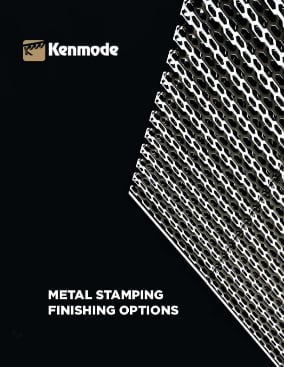What is Custom Metal Stamping?
A Comprehensive Guide
Custom Metal Stamping Overview
Custom metal stamping is, by definition, designed exclusively for a specific part and its functions. Unlike mass-produced stampings, custom metal stamping is chosen when precision and complex dimensions are required to produce a unique part. This process requires the upfront development of a custom metal stamping tool that cuts and forms the part as the metal goes through the stamping press. Custom metal stampings can range from large components for automobiles and custom assemblies to micro-miniature parts for medical devices or electronics.
Techniques for Shaping Custom Metal Stampings
Stamping includes a variety of sheet metal forming processes consisting of either a single station operation where every stroke of the press produces the desired form of the metal part or could occur through a series of stages. The following techniques are used to achieve the desired shape in the press.
Bending
Bending creates a formed feature by angular displacement of a sheet metal workpiece. In some processes, one edge of the workpiece is clamped in a stationary position while the other edge is clamped by a metal tool and bent over a form to create a precise bend or shape. Alternatively, the metal piece may be pushed into or against a form.
Blanking
The blanking process removes a metal piece from the primary metal strip or sheet when it is punched through the strip/sheet. The material that is removed becomes the new metal workpiece or blank.
Coining
Coining is a forming process that uses an extreme amount of pressure to push the workpiece into a die. The die then forms the metal into a precise shape and creates permanent forms in the workpiece. Coining also smooths the edges of metal parts by striking them with a high degree of force. This removes existing burrs and hardens the metal. Coining may reduce the need for deburring, grinding, and other secondary processes at the end of the project, which saves both time and money.
Crash/Crush Forming
This process deforms the metal using only a punch and cavity. These dies do not control metal flow and cannot prevent the metal from wrinkling or buckling. They are used to form simple parts, such as brackets and braces, made from thick, stiff metals that are more wrinkle-resistant than thinner metals.
Cutting
One of the most common stamping operations, cutting trims the metal into a part by the use of extremely high force in the stamping press. Cutting operations include trimming, notching, piercing, blanking, lancing, and shearing.
Drawing
A complex drawing die is used to create large metal parts, such as automotive components. The process involves controlling the flow of metal into a cavity via a pressure-loaded draw pad to prevent wrinkling as the material flows over a forming punch.
Embossing
Embossing is a cold-forming process used for creating specific formations or designs on metal pieces. Male and female embossing components press a workpiece between them with sufficient force to form the three-dimensional feature.
Extruding
Extrusion forms the metal inside the diameter of a pierced hole, which may be used for applications such as holding fasteners during part assemblies.
Flanging
The flanging operation bends metal along a curved axis, which may be used to form a projection or the rim of a part as it relates to part assembly and stiffness requirements.
Forming
Metal stamping involves a variety of forming operations. The stamping press forms the metal material by applying tension, compression, or both. The specific type of forming operation selected depends on the material’s properties and the part’s critical dimensions, balancing formability and strength.
Ironing
Similar to the coining process, ironing employs compression to form the part by squeezing the metal along a vertical wall to achieve exact thickness and length dimensions.
Lancing
In order to free up metal without separating it from the metal strip, lancing slices or slits the metal, which may be used in progressive dies as a part carrier.
Piercing
This metal cutting operation, also called perforating, produces a hole in a formed part or sheet metal, which may be round, square or a custom shape. The slug is then discarded.
Pinch Trimming
Pinch trimming is a special method in which the vertical walls of a drawn or stretched vessel are cut by pinching the metal.
Punching
This forming process uses a punch press to force a tool, called a punch, through the workpiece/material to create a hole and produces a scrap slug that is deposited into the die below the sheet metal.
Restriking/Sizing
Used primarily after major forming operations are complete, restriking employs an additional station in the die to finish precision details such as small embossing and sharp radii.
Shaving
An operation used to eliminate or minimize die-break, while maximizing the amount of sheared edge. The general concept with shaving is to pre-punch the hole slightly smaller, then post-punch the hole to size, using a very tight die clearance. This can also be done on a straight or outside edge.
Shearing
Cutting force is applied perpendicular to the material, causing the material to yield and break.
Trimming
The trimming process achieves the specified profile of a stamped part by forming its perimeter or cutting away excess metal, with precision trimming designed to minimize scrap.
Custom Metal Stamping Production Methods
The method chosen for metal stamping production takes into account the complexity of the part and how metal stamping can best form that part. For precision parts with tight tolerances, the method may include the use of in-die sensors to continually monitor part quality, along with other inspection methods. The method also takes into account secondary operations, such as plating, heat treating, welding, and cleaning or sterilization.
Progressive Die Stamping
Progressive metal stamping is a stamping process that advances a metal strip from station to station performing different operations on the same part in the die until the part is complete. Conical-shaped pilots are inserted into pre-pierced holes in the strip to ensure the precision of the alignment as the part advances to guarantee the accuracy of the finished product. Since the part is attached to a metal strip throughout its formation, the entire process and parts will be out of tolerance if the strip is off by even a tiny fraction of an inch.
Progressive die stamping offers some advantages such as being a highly repeatable process and since the material is continuously fed into the stamping press, long production runs can be completed, producing more finished parts in less time resulting in lower cost per part.
Progressive Stamping Delivers High Speed Production and Lower Costs.
Transfer die stamping
Transfer die stamping uses one press to operate multiple tools. The part is removed from its metal strip so that it can be freely transferred. A part, which can be turned or rotated, is shaped by each station until it is complete. Automation of the transfer process streamlines the operation into a single press.
Transfer dies can handle many part features in one press pass, such as holes, cut-outs or threading, which can eliminate costly secondary operations.
Transfer die stamping is typically used for large parts like frames, tube applications, draws, shells, and structural components.
Deep Drawing
Beneficial for applications requiring recessed cavities, where the depth of the drawn part exceeds its diameter, deep drawing uses blanking, swaging or sizing to deform the base material and apply recessed features.
Fine Blanking
Fine blanking is optimal for parts that require very smooth, precise edges or exceptional flatness. Fine blanking is particularly suitable for moving parts such as gears. Fine blanking is a combination of metal stamping and cold-metal extrusion techniques, requiring special presses.
Progressive Stamping vs. Fine Blanking: Three questions OEMs Should Ask
Multi-slide / Four-slide Stamping
Multi-slide / Four-slide stamping is best suited for fabricating complex components that have numerous bends or twists and for forming wire. The difference between multi-slide and four-slide is that four-slide metal stamping machines have four moving slides while multi-slide machines have more than four slides. The slides or rams in the machines strike the material to produce the finished parts.
Multi-slide / Four-slide equipment can manufacture complicated parts with multiple, complex, or over 90° bends and twists including clips, brackets, flat springs, terminals, retainers, and wire formed parts. Both flat and round materials can be formed.
L E A R N M O R E
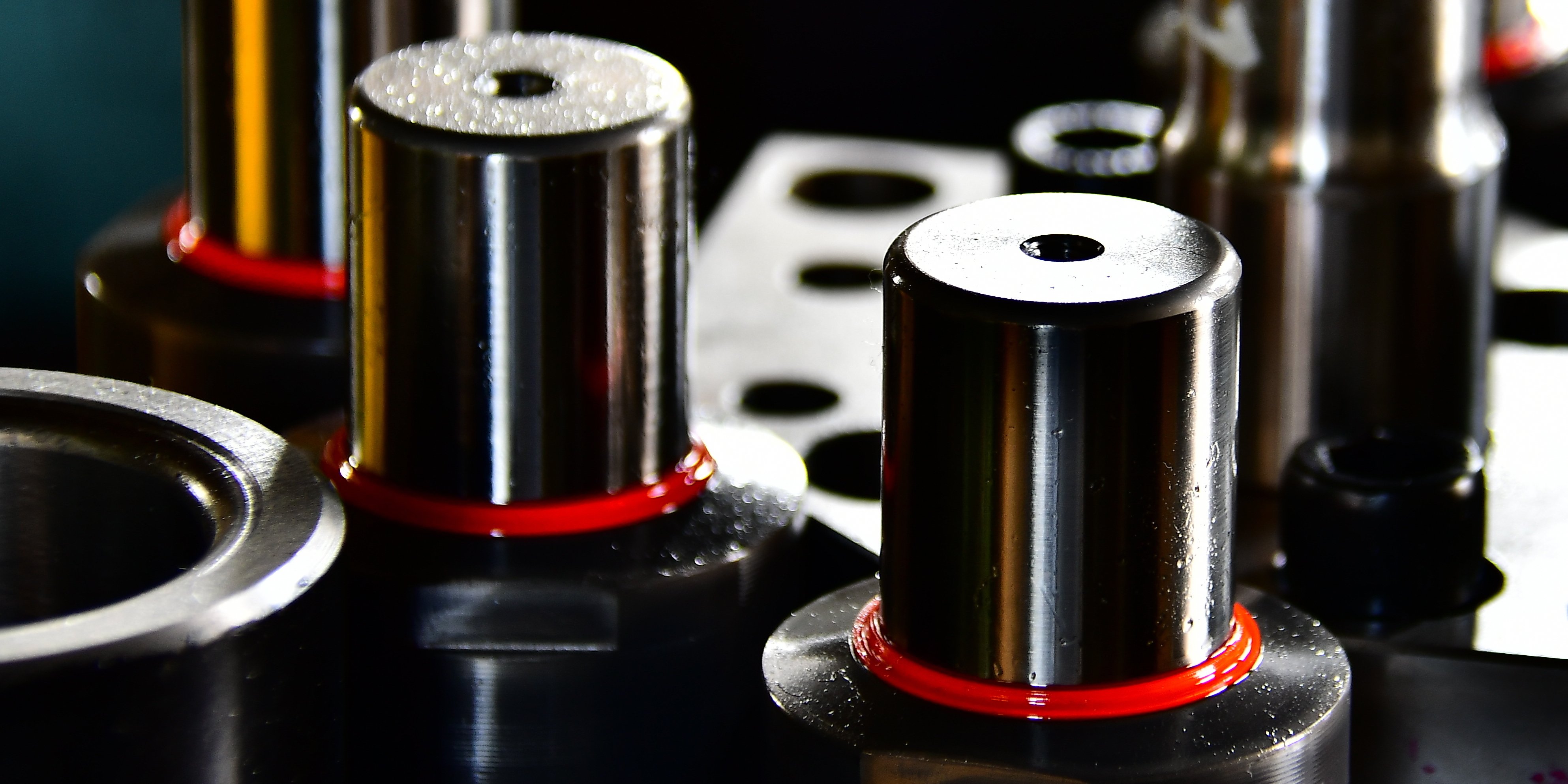
Progressive Stamping Delivers High Speed Production and Lower Costs
Progressive die stamping is a high-volume, high-performance metal stamping process that uses progressive dies, which perform multiple operations in ...
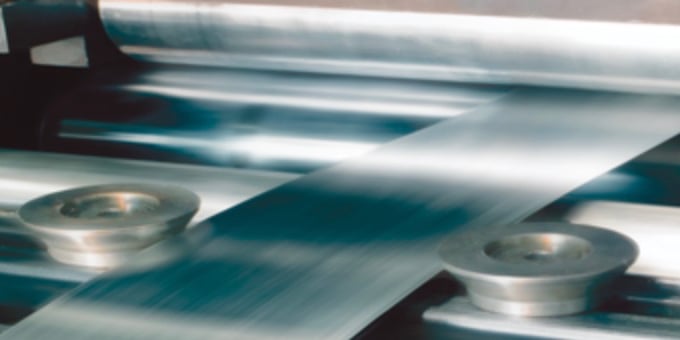
Progressive Die Stamping vs Transfer Die Stamping
If you’re responsible for designing or buying precision metal stamped parts, it’s important to understand when to use progressive die stamping versus ...
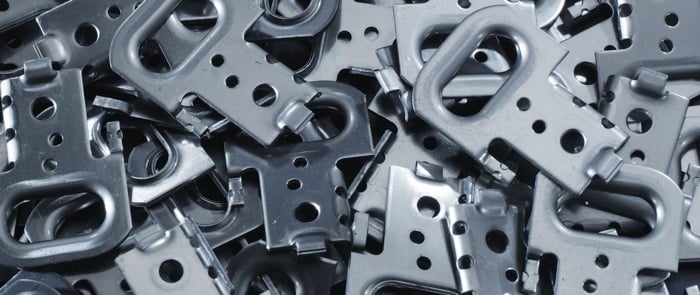
Progressive Stamping vs. Fine Blanking: Three questions OEMs Should Ask
For manufacturers who require precision parts with tight tolerances, it can pay to compare the options for manufacturing processes. Although fine ...
Precision Metal Stamping
Precision metal stamping provides the accuracy and speed needed to produce a high volume of parts quickly and to precise specifications. A variety of metals, from aluminum to titanium, can be stamped to produce precision parts requiring tight tolerances.
Precision metal stamping often is used to perform a number of operations quickly and cost effectively, including secondary operations in both the die and/or press, which eliminates extra steps and allows for high volume production.
- In-die welding
- In-die tapping and threaded inserts
- in-die fastener insertion
- In-die assembly
- In-tool machining of round pins
- Compliant pin technology
L E A R N M O R E
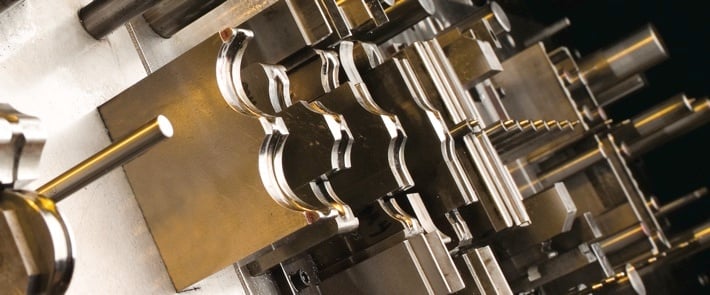
Using Multiple-Up Dies for Metal Stamping to Save Money and Boost Volume
Designing the metal stamping die to produce a new precision part is one of the most important steps to ensuring long-term success in production. ...

How Tight of a Tolerance Do You Need for Your Metal Stamping?
How tight of a tolerance do you need for your metal stamping? That’s a good question. The answer isn’t complex, nor is it simple and straightforward.
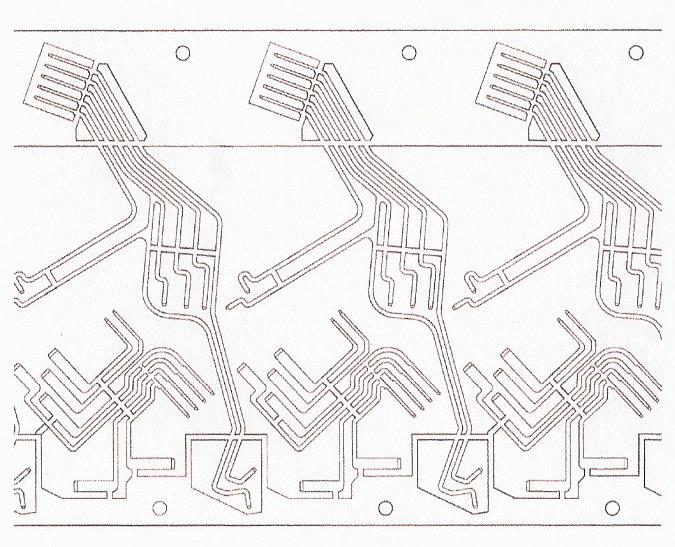
The Advantages and Disadvantages of Running Metal Stamping Family Dies
Family tooling is a method in which a manufacturer designs and builds a die that is able to simultaneously produce multiple components in different ...
Metal Stamped Parts
Precision metal stamping is typically used to produce high volumes of custom, complex parts requiring tight tolerances. The list below represents a sampling of precision metal stamped parts, organized by industry.
Automotive
- Busbars
- Engine Components
- Transmission Components
- Brake Components
- Safety-Related Devices and Seat Belt Components
- Windshield Wiper Arms and System Components
- Interior and Exterior Lighting Components
- Hose Clamps
- Brackets
- Retainer Clips
- Stays
- Supports
Medical Device
- Surgical Staplers components
- Suture removal components
- Implantable components
- Drug infusion pumps components
- Electrosurgery equipment components
- Medical/ Surgical Electronic contacts
- Biopsy device components
- Battery housings and contacts
- Antennas
- Trigger components
- closures for drug delivery devices and Pharma dispensing systems
- Needle safety devices
Electronics / Communications
- High-speed cable ends
- Busbars
- Contacts
- Electronic connectors
- Fiber optics components
- Battery housings and contacts
- Lead-frames
- LED lighting components
- Light pipes
- Terminals
- Shielding for radios
- Heat Sinks
- Switch components
- Relay components
- Spring Connectors
- Electric toothbrush components
Insert Molding
- Lead-frames
- Terminals
- Brackets
- Clips
- Supports
- Busbars
L E A R N M O R E
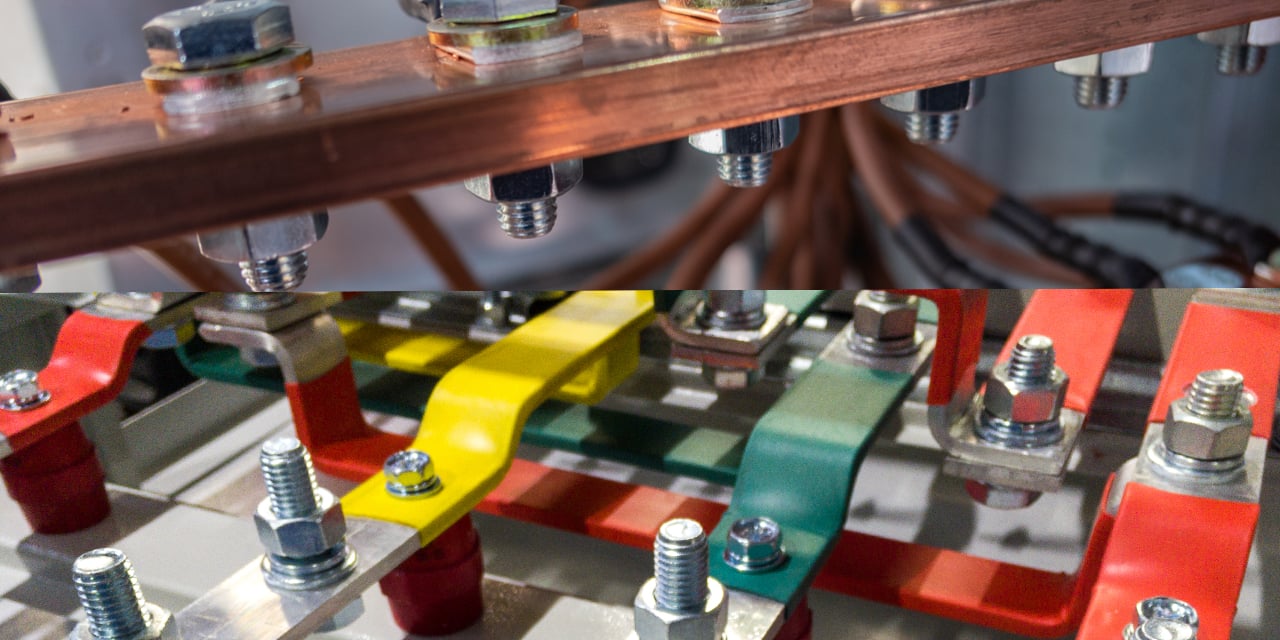
Copper vs Aluminum Busbars — Which Is Right for Your Project?
There is some debate regarding which material is better for use for busbars—aluminum or copper. Both materials have been used with success, but which ...
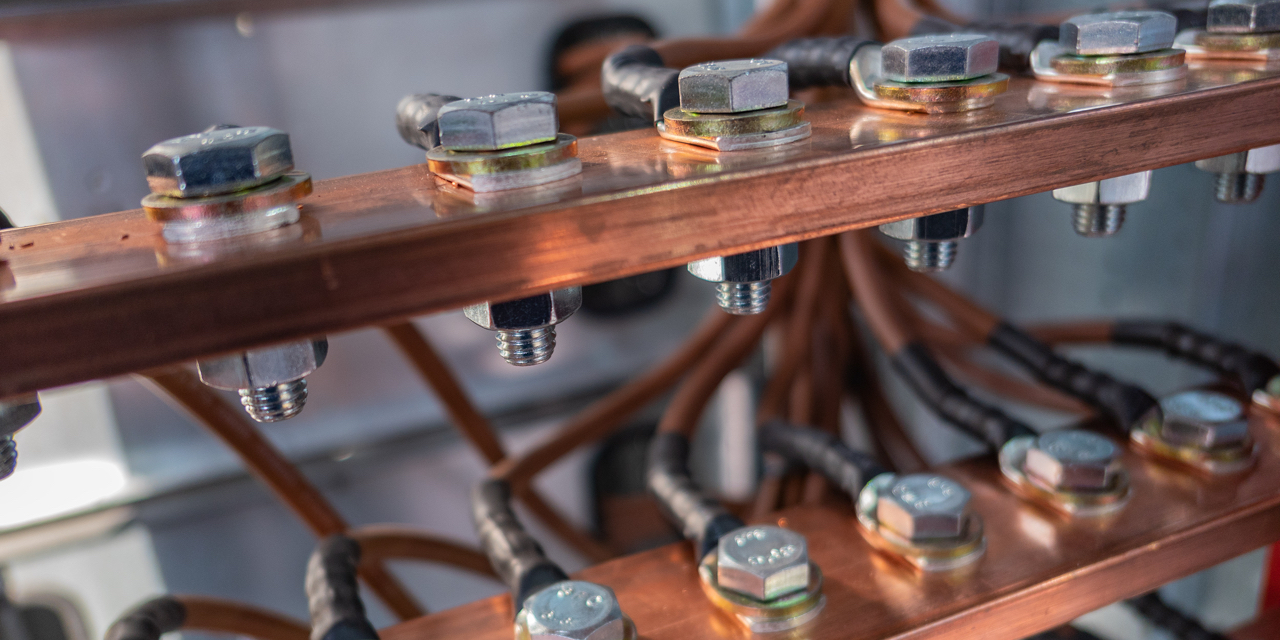
Growth in Electric Vehicles Driving Need for Metal Stamped Busbars
Demand is revving up for electric vehicles of all kinds, from cars to trucks to public transport. According to Bloomberg NEF market forecasts, ...
Metal Stamping Materials
A key factor in the success of a precision stamped part is specifying the best metal for the process and the application, ranging from lightweight aluminum to heavy-duty steel to high-cost precious metals. OEM engineers can benefit by consulting metal stamping specialists early in the part design phase to evaluate how metal stamping can work and the exact material specifications needed for the application at hand.
Material selection involves evaluating:
- The properties of the metal
- tensile strength
- elasticity
- conductivity
- heat capacity
- corrosion resistance
- weldability
- machinability
- formability
- The thickness and width of the material
- How well metal stamping can form to specifications with that material
- How the part will perform in the application and operating environment
- The material’s cost and availability
Typical Materials Used For Precision Metal Stampings
Some of the most commonly used materials for precision metal stamped parts include:
Steel
Carbon steel is one of the most popular materials used in metal stamping, which can take on many different forms, properties and finishes, offering optimal strength, performance and cost-effectiveness. Each year, steel production exceeds 1.3 billion tons worldwide. Basic steel is magnetic material. With the addition of chrome and nickel to make stainless steel, it loses its magnetic properties. Many different types of steel may be used including hot and cold rolled steel; stainless steel; high-tensile steel; low, medium and high carbon steel; and spring steel.
Aluminum
Aluminum offers many advantages for metal stamping applications. Aluminum has the highest strength-to-weight ratio of any metal. Aluminum conducts electricity better than copper and is non-magnetic. For companies seeking sustainability, aluminum is 100% recyclable without losing any of its natural characteristics. However, aluminum can be abrasive in tooling and is more expensive that steel.
Copper
Copper that is suitable for metal stamping comes in many forms, including such alloys as aluminum clad copper, brass, phosphor bronze, beryllium copper and aluminum alloys. Copper is often selected for stamped components and conductors for electronic devices, as well as electrical wiring, heating and plumbing, and other applications that require its extremely high electrical and thermal conductivity. Copper also resists corrosion while maintaining an attractive appearance. The softness of copper makes it one of the best metals for stamped parts.
Brass
With its reasonable price and flexibility, brass can work for almost any function in metal stamping. As an alloy of copper, brass can easily be soldered to copper. Brass is highly resistant to corrosion and will not rust. It is also effective in carrying electrical current while dealing with high stress very well. As a result of its unique properties, brass is one of the most-used metal materials in the world.
Titanium
Titanium is known for its corrosion resistance and high-impact toughness. Titanium is very expensive to manufacture but has the highest strength to density ration of any metallic element. It is often used in aerospace structures and implantable medical devices.
Precious Metals
Precious metals may be used as a plating or coating on stamped parts to increase conductivity or to add strength and corrosion resistance to the finished products. In metal stamping, designing a process that conserves the precious metal is critical, due to its high cost and limited availability in some cases. Manufacturers in the automotive, electronics, telecommunications and medical device industries are among the leading users of precious metals such as gold and palladium in critical parts.
Nickel Alloys
Nickel alloys resist high pressure and maintain their properties under extremely high temperatures. They also offer high strength and toughness and excellent resistance to atmospheric corrosion. High nickel alloys are perhaps the most frequently used material for metal stamping production among the hundreds of specialty alloys used in the industry.
Metal Stamping Materials by Industry
Each industry favors particular metals for their precision metal stampings, due to their unique applications and the environmental and operating conditions that the parts must withstand. For example, stamped parts for the automotive industry must be able to hold up under extreme heat and cold, as well as contact with a variety of liquids, while medical devices require high sanitation and safety standards, and electronic parts require electrical conductivity.
Automotive
- Red Metals including Copper, Bronze and Brass
- High-Strength, low-alloy Steel
Medical Device
- Stainless Steel
- Titanium
- MP35N
- Platinum Iridium
- Niobium
- Tantilum
- Aluminum
- Copper
- Custom shaped wire
Electronics
- Mill hard or post heat-treated Beryllium Copper
- Phosphor Bronze and a wide array of high-performance alloys
- Aluminum Clad Copper
- Custom shaped wire
Insert Molding
- Brass and high-performance copper-based alloys
- Pre-plated ferrous and non-ferrous alloys
- Aluminum clad copper
- Custom shaped wire
L E A R N M O R E
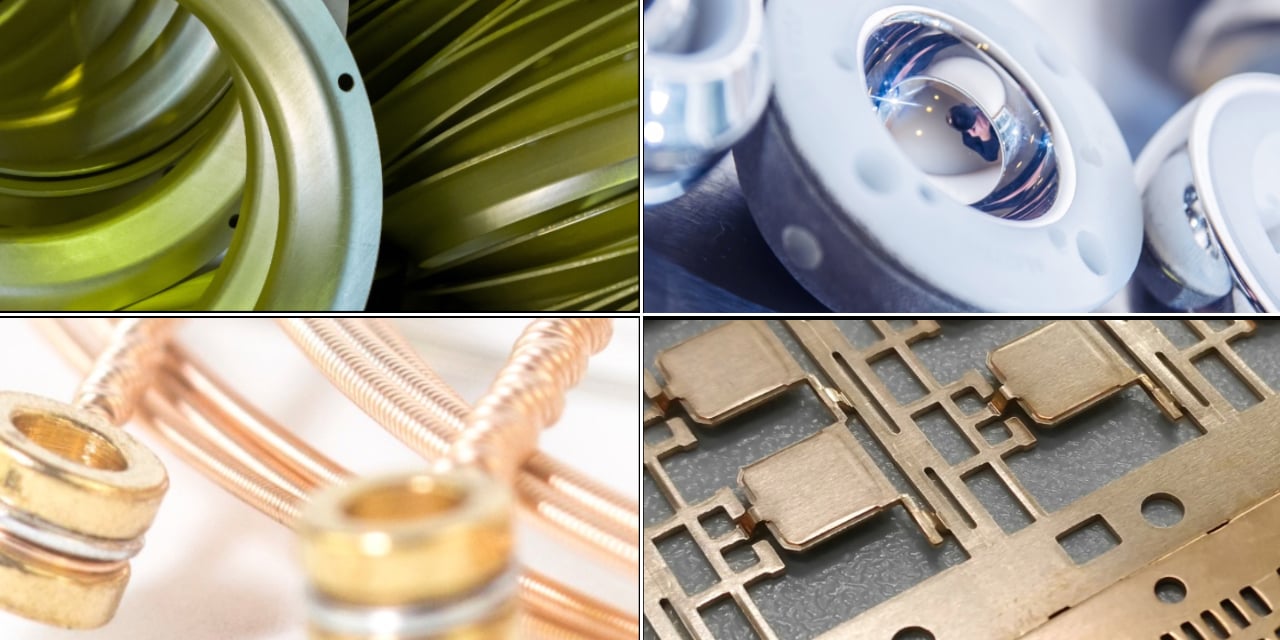
Choosing the Right Metal Stamping Material
Precision metal stamping is one of the most popular manufacturing processes for various industrial applications because it is quick, accurate, and ...
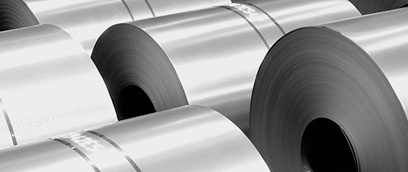
Steel Market Impacts Metal Stamping Lead Times and Prices
With steel one of the top metals used in metal stamping, global market fluctuations in the supply and demand for steel have been pushing steel prices ...

Designing the Metal Stamping Strip to Minimize the Use of Precious Metals
Manufacturers in the automotive, electronics, telecommunications and medical device industries are among the leading users of precious metals such as ...
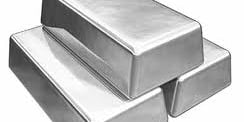
Silver May be Low-Cost Solution for Plating Electronic Connector Stampings
Not long ago we featured a blog article about the use of palladium as an alternative to gold for plating electronic components due to the rising ...

It's Time to Consider Palladium for Electronics Plating -- Again.
Author: Vince Azzano, Director of Technical Sales, Precision Plating Company Fabricated gold prices are at an all-time high, and traders and analysts ...
Metal Stamping Process
Production of precision metal stampings involves a complex process that begins with design collaboration between the stamper’s and the manufacturer’s engineers. Software simulations are often followed by developing a prototype tool to produce sample parts. Full production planning takes into account every step of the process from custom tool design and stamping through finishing and assembly/packaging to ensure that all critical specifications are met, with quality control from start to finish.
Design Engineering Assistance
Metal stamping engineers can offer solutions for cost-effective part design and production upfront during the estimating process, as they review the part design, prints and material specifications. Using advanced technology, such as 3D CAD, metal stampers can test design options and recommend improvements to reduce failure risk and increase functionality, while meeting all critical specifications and quality standards.
Prototyping
With the development of new custom stampings, it can pay to test and analyze small quantities of stampings before investing in full production. By building a prototyping tool to run sample parts and using simulation software to evaluate how the part and material will function in the tool, the metal stamper can identify and correct potential weaknesses prior to production, which saves on development costs and time to market. The stamper may recommend specialized tool functions, such as progressive dies or in-die assembly, to improve manufacturability.
Production Planning
Collaboration between the manufacturer's technical staff and the metal stamper's engineers in the initial planning stage is key to ensuring efficient production and long-term functionality of the part. In-depth planning sessions allow for review of:
- part specifications
- industrial applications/operating environment
- industry and statutory/regulatory requirements
- industry quality standards (i.e. APQP, DQ/IQ/OQ/PQ)
- unusual risks
- material characteristics
- required secondary operations
- tooling parameters
- control plans
- final assembly/packaging requirements
- demand variances
For manufacturers in the planning process for new products, the technical team of the precision metal stamper can add valuable guidance upfront to help speed time to market.
A designated project manager is responsible for ensuring the project is completed on time and on budget and for communicating status updates to the cross functional team.
Tool Design, Build and Maintenance
Tool designers review technical specifications and provide critical feedback for tool design. Once designs are approved, highly complex, high-precision tools are built, often including in-die sensors to ensure tool safety and consistent quality. Tooling experts conduct preventative maintenance to ensure tools last the duration of the program with little or no downtime.
Precision Metal Stamping
Sophisticated technology is used for high-speed, precision metal stamping, with a variety of presses that are augmented with advanced features such as electronic servo feeds, robotics, and real-time quality control. Multiple operations like in-die tapping, in-die fastener insertion and in-die assembly can be performed in the stamping press, which can eliminate the need for those secondary operations.
Secondary Operations
Secondary operations are often required to fully finish the metal stamped part for seamless integration into a product or system. Parts may need to be trimmed or welded. Finishing techniques such as coating, plating, polishing or deburring may be chosen to inhibit corrosion, improve appearance, or smooth sharp edges. Metal stampers provide many services in-house, such as cleaning and custom assembly, and also coordinate with approved suppliers for specialized metal finishing services, such as welding or electropolishing.
Assembly and Packaging
Metal stamping engineers evaluate assembly and packaging needs in the production planning phase to ensure finished parts are ready for further production or shipment when delivered to the manufacturer. Parts may be shipped fully assembled or as sub-assemblies and packaged based on manufacturer specifications (i.e. reel-to-reel, loose piece, on a bandolier).
Quality Control
Precision metal stampers apply mistake-proof processes that incorporate quality controls into every phase of a metal stamping project. Company-wide information sharing systems ensure quality commitments are understood and implemented by every project team member. Sophisticated quality control technology is leveraged throughout the process to ensure zero defects, such as in-die sensors, real-time statistical process control, and optical vision systems.
L E A R N M O R E
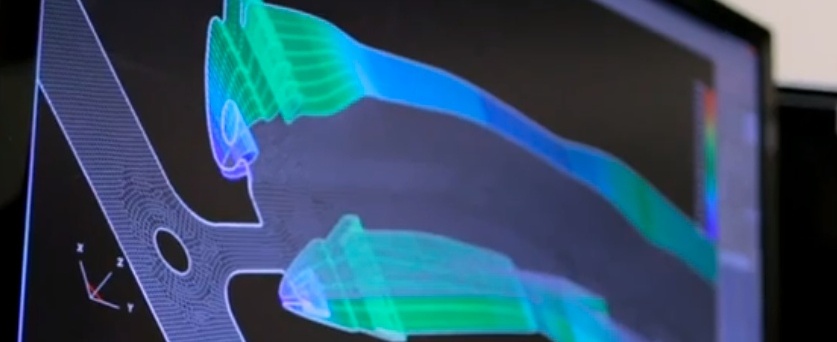
How Metal Stamping Simulation Software Saves Money
Simulation software is a powerful aid to new product development in industries as diverse as automotive, aerospace and medical devices. Finite ...

Metal Stampings Have Limitations – Keep Them in Mind when Designing Your Part
Computer-aided design (CAD) is a wonderful technology that can lead product engineers and designers to think that anything is possible. After all, ...
Metal Stamping Tooling
Tool Design
The design of a custom tool to produce each new part is critical to success. The tool design is driven by the complexity of the part, the type of stamping method to be used, the expected reaction of the metal to that process, and the anticipated volume and desired run-at rate of parts, among other factors.
Developing a metal stamping tool may require:
- An engineering review of the manufacturer’s part design and prints, the industrial application of the part, and its expected useful life
- Understanding the part's function in conjunction with an assembly or how it interacts with other components downstream
- An evaluation of material specifications for the finished tool
- Rapid prototyping of a custom metal stamping tool
- 3D simulation to evaluate how the material and the part will function in the tool.
How Precision Metal Stampers use 3D Stimulation Software to Design Tooling - Determining the best use of machining, grinding, wire EDM, and other manufacturing services to produce the tool and limits, tolerances, and ranges that can be held by each process
- Defining quality parameters and control plans, as well as final assembly and packaging requirements
Tool Maintenance
Tool maintenance is critical to ensure the tool is in ready-to-run condition throughout the life of the program. Proper maintenance ensures quality tooling and quality parts.
Tool maintenance teams typically:
- Staffed in-house to ensure tools consistently run to exact specifications at all times
- Conduct preventive maintenance of tooling and equipment on regular basis
- Consider maintenance requirements when designing tool
- Keep record of maintenance activities and issues
Tooling Technology
Advancements in tooling technology include:
- 3D tool design and simulation software
- Wire EDM for making intricate parts
- state-of-the art sensors to protect the tool and maintain part quality
L E A R N M O R E
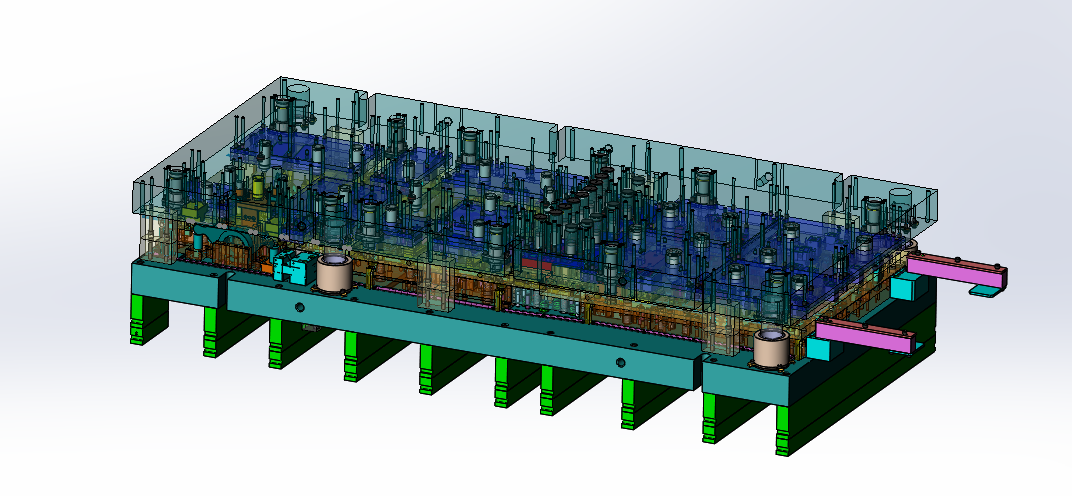
How Precision Metal Stampers Use 3D Simulation Software to Design Tooling
Today’s precision metal stampers are turning to sophisticated 3D simulation software to produce high quality parts.

Metal Stamping Sensors Boost Efficiency, Quality
In precision metal stamping, every stroke of the press exerts tremendous pressure on the metal being formed, which can lead to unpredictable problems ...

Why a Single-Source Metal Stamping Company Might Be the Right Decision
When a metal stamping company develops your product from design through production in-house, there's a greater chance you'll get your parts on time ...
Metal Stamping Secondary Operations
Precision metal stampings may require one or more secondary operations in order for the stamping to meet all critical specifications prior to shipment to the OEM. Metal stamping firms may offer a number of these operations in-house, such as cleaning, assembly, and packaging. However, some secondary operations, such as e-coating, electropolishing, heat treating, and plating, require technical expertise and equipment available only through specialized suppliers.
The metal stamper’s engineering team can provide guidance upfront on the best processes for the stamping and its application and will include those secondary operations in its estimate. In addition, the stamper will oversee the secondary operations provided by approved suppliers in order to finish, inspect, package, and ship the stamped part to the manufacturer’s exact specifications.
Typical Secondary Operations
- Secondary tooling to trim parts or to form and cingulate at the customer location
- Forming and laser welding
- Welding and spot welding
Metal Finishing
- Cleaning and passivation
- Deburring
Deburring Improves Performance and Appearance of Metal Stampings - Electropolishing
The Benefits of Electropolishing for Your Precision Metal Stamped Part - Heat treating
Heat Treating Techniques to Strengthen Metal Stampings - Overmolding of medical-grade elastomers and polymers
- Painting, powder coating, e-coating, and other finishes
Powder Coating and E-Coating Improve Corrosion Resistance and Appearance of Metal Stampings - Plating: pre-, post- and spot, precious and non-precious metal plating
How Metal Plating Enhances Stamped Parts
Packaging
- Reel to reel
- Tape and reel
- Loose piece
- Parts supplied on a bandolier
- Custom packaging
- Returnable packaging
- Export services
- Labeling and bar coding
Assembly
- Manual
- In-Die
L E A R N M O R E

Finishing Options for Metal Stampings
When designing and producing precision metal stamped components, engineers and project managers representing the manufacturer, its suppliers, and the ...

Heat Treating Techniques to Strengthen Metal Stampings
Heat Treating Techniques to Strengthen Metal Stampings Custom metal stampings may require heat treating after stamping to achieve an OEM’s ...
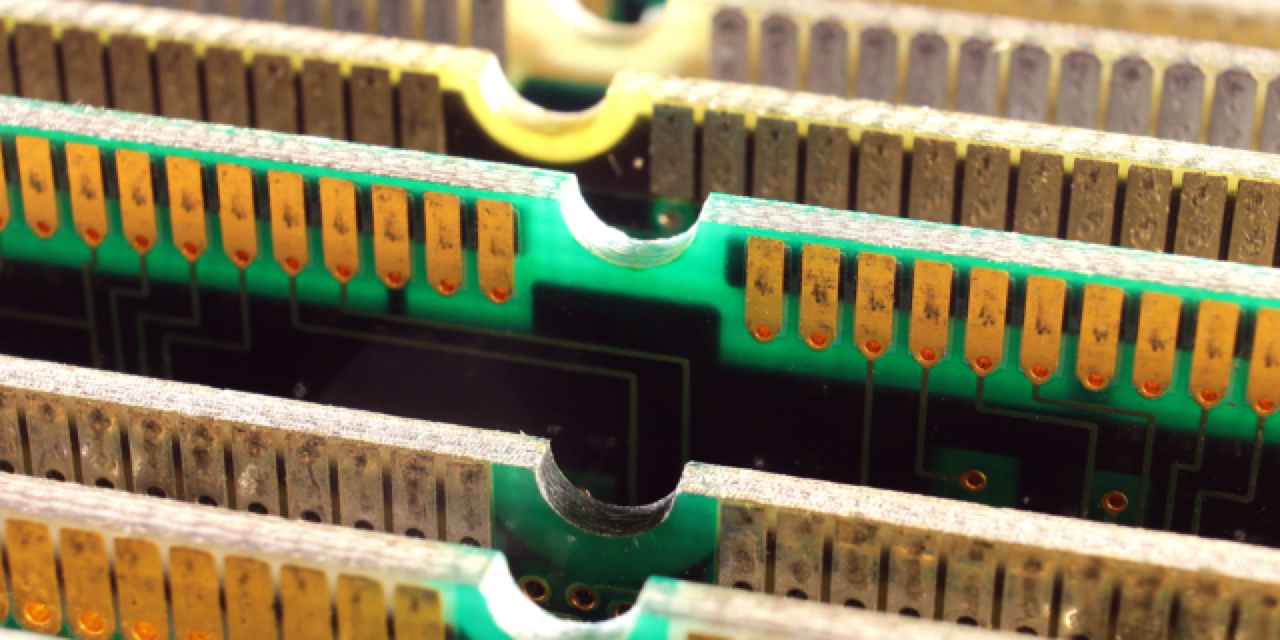
How Metal Plating Enhances Stamped Parts
A wide range of custom metal stampings require metal plating as part of the finishing process – from large automotive parts to miniature components ...
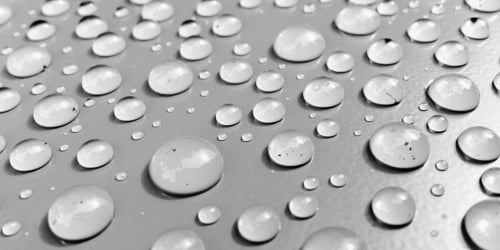
Powder & E-Coating Improve Metal Stamping Corrosion Resistance/Appearance
Of the many finishing options available for metal stampings, powder coating and electro-coating (e-coating) are often preferred by automotive OEMs ...
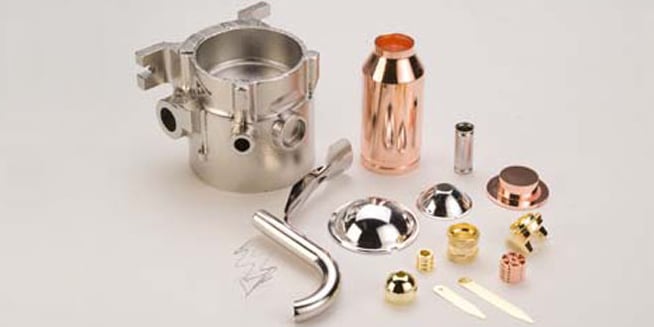
The Benefits of Electropolishing for Your Precision Metal Stamped Part
Because the metal stamping process puts metal under enormous pressure in order to achieve the desired form, components may require polishing after ...
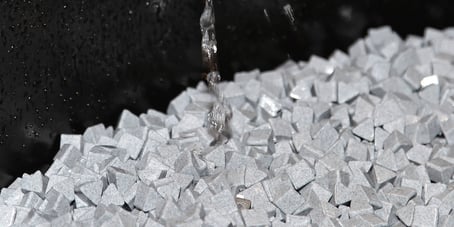
Deburring Improves Performance and Appearance of Metal Stampings
The metal stamping process uses heavy tonnage presses to form a wide variety of metal materials, which can produce burrs – excess metal in a rough or ...
Metal Stamping Quality Control
Delivering consistent quality requires a robust system to prevent problems and detect variances in real time. The components of a quality control system include:
- Quality Control Processes designed to meet each customer’s requirements for the part and any quality guidelines specific to their industry
- High-Tech Equipment to perform measurements and inspections during production to spot potential problems as they occur
- Information technology to continually track quality measurements
- Proof of quality control through general ISO and industry-specific certifications
- Company-wide training and commitment to zero defects
Quality Control Processes
The following processes are critical to ensuring metal stamping quality.
- Collaborative Product and Process Design (CPPD)
- Design for Manufacturability (DFM)
- 3-D Simulation Software
- Failure Modes and Effects Analysis (FMEA)
- Statistical Process Control (SPC)
- Gauge Repeatability and Reproducibility (GR&R)
Quality Control Equipment
A metal stamper dedicated to delivering consistent quality will employ a variety of advanced quality control systems and inspection devices, which are used to detect potential problems throughout production in real time.
- Statistical Process Control (SPC) systems
- Coordinate Measurement Machines
- Optical Vision Systems
- Functional Gauges and Custom Gauges
- In-Die Detection Sensor Systems
Company-Wide Information Sharing System
A valuable tool to ensure quality is a company-wide information system that tracks and documents every step of the process from design to production quality measurements to inventory and shipping. Important documentation and databases should be readily available to employees at the point of use and to provide timely quality reports to customers as required.
IT documentation and databases may include:
- Project scheduling and tracking
- Production instructions and blueprints with revisions
- Quality control plans and reports
- Internal system audits
- Equipment and tool and die maintenance databases
- Calibration database for inspection equipment
- CAPA Corrective Action Preventative Action
- Traceability through the entire process
- Inventory management
- Shipping date by part number
Quality Certifications
The International Organization for Standardization (ISO) certifications ensure that a metal stamper meets the quality management standards required in the global marketplace as well as in specific industries.
ISO 9001
Widely used, general standard that requires companies to establish, document, implement, and maintain a quality management system and to continually improve its effectiveness.
IATF 16949
Defines requirements for the design, development, production, installation, and service of automotive-related products. The standard is also accepted by other industries such as aerospace and electronics.
ISO 13485
Specific to the medical industry, emphasizing the design, process, quality, and manufacturing reliability of medical device products.
ISO 14001
Sets out the criteria for and maps out a framework that a company or organization can follow to set up an effective environmental management system.
Industry Quality Standards
Manufacturers of products that are particularly complex or that must meet stringent safety and performance requirements have developed their own quality standards and processes, in such industries as automotive, medical devices, insert molding, and electronics.
Automotive Industry
Employs Quality Core Tools for metal stampings and other components, including:
- Advanced Product Quality Planning & Control Plan (APQP)
- Production Part Approval Process (PPAP)
- Failure Modes and Effects Analysis (FMEA)
- Measurement System Analysis (MSA)
- Statistical Process Control (SPC)
Medical Device Industry
Uses a variety of methods to ensure quality, including:
- Failure Modes and Effects Analysis (FMEA)
- DQ/IQ/OQ/PQ: Design, Installation, Operational and Performance Qualifications to ensure that the device will function as specified, as spelled out in the ISO 13485 standard.
Company-Wide Commitment to Zero Defects
Quality guru Philip B. Crosby, in his book “Quality is Free,” puts forth the ideal of zero defects. He asserts that the quality and inspection department does not ensure quality by itself. Instead, it takes a complete commitment to delivering zero defects from all employees – with a company culture that expects nothing less than perfection.
Management Investment in Best Practices
Ensuring quality, of course, is not free. Management at all levels must demonstrate a commitment to quality by investing in the processes and procedures that deliver quality stampings, time after time.
Best practices for quality metal stampings include:
- Risk based process orientated approach
- A strong prevention focus to avoid quality issues
- Advanced detection and inspection systems to identify problems as soon as they occur
- A process for verifying root causes, taking corrective actions and making permanent changes as needed
- Regular training in quality standards and best practices for every employee
L E A R N M O R E
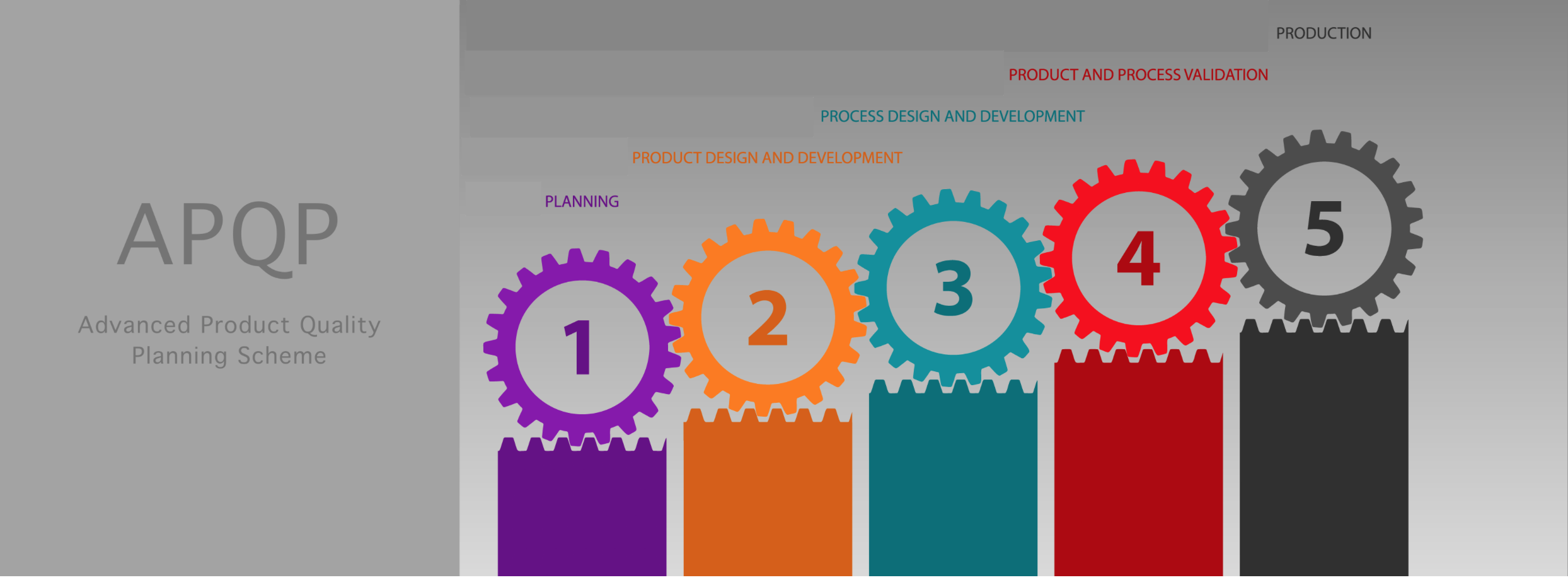
Metal Stamping Defects Not an Option for Automotive Stamped Parts
In an increasingly global automotive market, suppliers such as precision metal stamping firms must be able to deliver parts with zero defects and ...

Metal Stamping Defects Can Spell Disaster for Medical Devices
Defective medical devices are costing manufacturers billions of dollars every year. Even more alarming, defects can lead to patient death and harm. ...
How to Evaluate and Select a Custom Metal Stamping Manufacturer
Manufacturers looking to add or replace a metal stamping supplier face a daunting task of evaluation and selection. While an RFQ is an important step, it’s not enough in itself to evaluate the stamper’s qualifications. When it comes to what drives their decisions, the top ten demands of metal stampers are almost universal among manufacturers – particularly the first three.
Top 10 OEM Demands for Assessing Metal Stamping Firms
Manufacturers routinely demand the following from their metal stamping suppliers:
- Best Price
- Top Quality
- On-Time Delivery
- Engineering Depth
- A Single Source
- Global Competitiveness
- Flexibility
- Latest Technology
- Financial Stability
- A True Partner, not just a Supplier
With price, quality and on-time delivery so critical, it pays to research the company’s track record and to understand the many factors that influence the all-in price of custom metal stampings.
Schedule Site Visits to Metal Stamping Companies
An evaluation of the stamper's qualifications on paper may not be enough to make a final decision. To effectively evaluate whether the metal stamping firm meets their long-term performance standards, OEMs should schedule site visits to one or more metal stamping companies. Technology plays a major role today in the metal stamping industry. It can pay to see the latest technology in action, as well as to assess the team of engineers, technicians, and top management that make the operation run smoothly.
L E A R N M O R E

What to Look for at Site Visits to Metal Stamping Companies
Manufacturers who are considering adding or replacing a supplier of precision metal stamping face a daunting task of evaluation. Often, the process ...
How to Ensure a Successful Tool Transfer
Manufacturers may consider transferring metal stamping tools to a new stamper for any number of reasons. These may include:
- Obtain competitive bids
- Minimize risk by diversifying suppliers
- Achieve production efficiencies
- Address quality issues.
However, the transfer can present challenges, especially if it’s a rush request. Understanding the transfer process and allowing sufficient time for evaluation will result in the best outcome.
Step 1. Request Quotes From One or More Metal Stamping Firms
In order to provide an accurate estimate, the manufacturer will need to supply as much information upfront to the stampers as possible, including:
- Sample of the part
- Part print and specifications
- Expected production volume
- Production history and any quality concerns
- Strip width and progression
The stamper’s initial quote will include the cost of running the tool and producing the parts, based on the existing tool and information provided.
Step 2. Ship Existing Tool to Preferred Stamper for Inspection
The stamper’s engineering team will evaluate whether the tool can be used as is or if a repair or redesign may be required to bring it up to company tool standards. In some cases, developing a new tool may be the best option. In any case, the stamper will provide cost estimates for various scenarios. If it isn’t possible to ship the tool in advance, the stamper can inspect the tool at the customer's location.
Step 3. Review Stamper’s Tool Recommendations
With any tool transfer, cost, quality and time factors must be considered. In many cases, the existing tool can be used. However, the tool may be damaged beyond repair, exhibit too much wear, or can no longer meet print specifications. In that case, the stamper may need to build a new tool, which may take advantage of the latest metal stamping technology and operate more cost efficiently.
L E A R N M O R E

How to Smoothly Transfer Tools to a New Metal Stamping Supplier
From economic downturns to natural disasters to industrial accidents, the huge upheavals in the global manufacturing supply chain in recent years ...
Table of Contents
- Custom Metal Stamping Overview
- Precision Metal Stamping
- Metal Stamped Parts
- Metal Stamping Materials
- Metal Stamping Process
- Metal Stamping Tooling
- Metal Stamping Secondary Operations
- Metal Stamping Quality Control
- How to Evaluate and Select a Custom Metal Stamping Manufacturer
- How to Ensure a Successful Tool Transfer
Algonquin, IL 60102-2486
about
Get answers to your questions
Browse our Custom Metal Stamping Guide
Industries
- Privacy Policy
- Terms & Conditions
- Certifications (ITAR, ISO 9001, ISO 13485, ISO 14001, IATF 16949)







